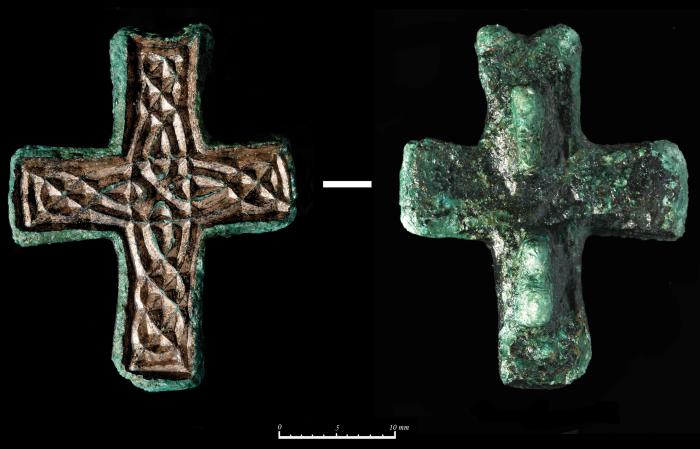TII Archaeology at the National Museum of Ireland
By TII Archaeologist Michael Stanley
On 16 September 2020, the National Museum of Ireland launched Glendalough: Power, Prayer and Pilgrimage, a new exhibition that explores one of Ireland’s most important monastic sites across the centuries and features 26 artefacts that are on exhibition for the first time. Among these is a cross-shaped object of gilded copper alloy that was discovered in 2005 during pre-construction excavations at Ask, Co. Wexford, on the N11 Arklow–Gorey Link Road.
This object, dating from the 8th century AD, is embellished with what is termed chip-carved interlace decoration. It is of Irish manufacture and, as the two projections at the back indicate, it would have been mounted onto a larger item originally (e.g. a religious shrine or horse harness) and is therefore referred to as a ‘cross mount’. As can be seen from the 10 mm scale in the photo below, it is quite small. If you held it in your hand, it would just about cover a quarter of your palm.

(Photos by John Sunderland)
The cross mount was found in a pit that contained traces of (unidentifiable) cremated bone. This pit was one of seven cremation burial pits excavated at the centre of a circular enclosure (designated Structure E), with an entrance to the north-east. The enclosure has been radiocarbon-dated to AD 810–1000, placing it in the early medieval period. One of the cremation pits dated to AD 640–770. Therefore, the burial that the cross mount accompanied is among the latest cremations yet recorded in Ireland. During this period of history, the customary burial rite was inhumation, so these cremation burials are unusual. At an early stage of the post-excavation analysis, Excavation Director Paul Stevens speculated that the burial with the cross mount might be that of a pagan Viking buried with Irish plunder, but further study suggested that the burial likely represents the resting place of a native Irish person interred during the Christian/pagan transition at an ancestral cemetery known as a fert. This cemetery was one of numerous, mostly prehistoric, funerary monuments constructed at Ask over millennia and the true complexity of the site is conveyed in two papers by Paul Stevens (see further reading below).

(Plan of Structure E by Valerie J Keeley Ltd)
While thousands of artefacts have been uncovered during pre-construction excavations on TII projects, few go on display in the National Museum. The cross mount from Ask will be on temporary exhibition for the next two years. Should you visit the Museum to view it, be sure to also see the 7,000-year-old Mesolithic basketry fish-traps and miniature wooden boat from Clowanstown, Co. Meath, which were excavated on the M3 motorway and are on permanent display. These extraordinary fish-traps were included in Fintan O’Toole’s book A History of Ireland in 100 Objects and featured in the An Post Ninth Definitive Stamp Series.
Further reading
Stevens, P 2007 'Burial and ritual in late prehistory in north Wexford: excavation of a ring-ditch cemetery in Ask townland', in J O'Sullivan & M Stanley (eds), New Routes to the Past, 35–46. Archaeology and the National Roads Authority Monograph Series No. 4. National Roads Authority, Dublin.
Stevens, P 2012 'Burial and ritual in early medieval north Wexford: new evidence from Ask townland', in B Kelly, N Roycroft & M Stanley (eds), Encounters between Peoples, 49–60. Archaeology and the National Roads Authority Monograph Series No. 9. National Roads Authority, Dublin.
The technical excavation report on the site at Ask can be accessed via the TII Digital Heritage Collections.
(Posted 25 September 2020)
More on the Glendalough: Power, Prayer and Pilgrimage Exhibition